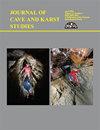New Evidence Confirms the ~250 K.y. Duration for Deposition of the Paleocene Ojo Alamo Sandstone in the Southern San Juan Basin, New Mexico
IF 0.5
4区 地球科学
Q4 GEOSCIENCES, MULTIDISCIPLINARY
引用次数: 0
Abstract
The dinosaur-bearing Ojo Alamo Sandstone (OAS) of the San Juan Basin (SJB), NM and CO, is earliest Paleocene based on palynologic data from multiple localities. An unconformity of 7-8 m.y. separates the Paleocene OAS from underlying Cretaceous strata in the southern SJB – Maastrichtian-age strata are absent there. Previous publications show that OAS dinosaur bones were not reworked but were fossilized in place. The OAS averages 15-30 m thick in the southern SJB and is up to 130 m thick further north in the basin. The first altered volcanic ash bed ever found in the Nacimiento Fm. was discovered in the southeast SJB 64 m above the top of the OAS near Cuba, NM. Sanidine grains from this ash bed had a 40 Ar/ 39 Ar age of 64.60 Ma (adjusted). Based on an estimated rate of deposition for the lower Nacimiento Fm., the age for the top of the underlying OAS was determined to be 65.7 Ma. Subsequently, a second Nacimiento ash bed was found only 10.5 m above the top of the Ojo Alamo with a reported 40 Ar/ 39 Ar sanidine age of 65.49 Ma . This ash bed was found near De-na-zin Arroyo in the southwest part of the SJB. Again, based on an estimated rate of deposition for the lowermost Nacimiento Fm, the top of the underlying OAS was calculated to be 65.7 Ma. In addition, a detrital sanidine age for the top of the OAS in the southern part of Cuba, NM was reported to be 65.67 Ma, in agreement with the ages above. And a very recent paper (2020) discussing the paleomagnetism of the Nacimiento Fm., suggests an age of 65.67 Ma for the base of magnetochron C29n, a few meters above the top of the OAS. These new data also support an age of 65.7 Ma for the top of the OAS in the southern SJB. Previous publications have estimated the base of the OAS to be ~65.95 Ma, thus the duration of OAS deposition in the southern SJB must have been ~250 k.y. This duration of OAS deposition in the southern SJB of about a quarter-million years is thus confirmed by recent data. It must be cautioned that in those parts of the basin to the north, where the OAS is thicker, the time interval for its deposition could have been proportionally greater and have a younger upper boundary. Some workers (mostly vertebrate paleontologists) have suggested that the OAS consists of two members: a lower, dinosaur-bearing member of Cretaceous age separated from the upper part by an imagined unconformity of millions of years. This report shows that the undivided OAS was deposited over about 250 k.y. in the southern SJB. There is no stratigraphic evidence on OAS outcrops around the basin for a significant break in deposition within this formation; indeed, OAS outcrop observations clearly show otherwise. Voluminous palynologic data, published heretofore, unequivocally support the top-to-bottom Paleocene age for the dinosaur-bearing OAS throughout the SJB. None of these data have ever been falsified.新证据证实新墨西哥州圣胡安盆地南部古新世Ojo Alamo砂岩沉积时间约250ky
根据多地孢粉学资料,圣胡安盆地(SJB)的Ojo Alamo砂岩(OAS), NM和CO是最早的古新世。在SJB南部,古新世OAS与下伏白垩系地层之间存在7 ~ 8 m.的不整合,没有马斯特里赫特时代地层。先前的出版物表明,美洲国家组织的恐龙骨头没有被重新加工,而是在原地变成了化石。在SJB南部,OAS平均厚度为15-30米,在盆地北部,厚度可达130米。这是在Nacimiento火山发现的第一个蚀变火山灰床。发现于SJB东南部,距离美洲国家组织顶部64米,古巴附近。经校正后,该火山灰层的40 Ar/ 39 Ar年龄为64.60 Ma。根据对较低的Nacimiento Fm沉积速率的估计。,下伏OAS顶部的年龄为65.7 Ma。随后,在Ojo Alamo顶部仅10.5米处发现了第二个Nacimiento火山灰床,据报道其40 Ar/ 39 Ar的碱化年龄为65.49 Ma。这个火山灰床是在SJB西南部De-na-zin Arroyo附近发现的。同样,根据对最下层Nacimiento Fm沉积速率的估计,计算出下伏美洲大陆的顶部为65.7 Ma。此外,古巴南部美洲国家组织顶部的碎屑岩年龄为65.67 Ma,与上述年龄一致。最近的一篇论文(2020年)讨论了Nacimiento Fm的古地磁。,表明C29n磁时线底部的年龄为65.67 Ma,位于美洲区顶部上方几米。这些新数据也支持SJB南部美洲国家组织顶部的年龄为65.7 Ma。以前的文献估计美洲国家组织的基底为~65.95 Ma,因此,美洲国家组织在SJB南部的沉积时间必须为~250 ky。因此,最近的资料证实了美洲国家组织在SJB南部的沉积时间约为25万年。必须提醒的是,在盆地北部的那些地区,美洲国家组织较厚,其沉积的时间间隔可能成比例地更大,并且有一个更年轻的上边界。一些工作人员(主要是脊椎动物古生物学家)认为美洲大陆由两个部分组成:一个较低的白垩纪时期的有恐龙的部分,由于想象中的数百万年的不整合而与上部分开。这份报告显示,未分割的美洲国家组织沉积在南西南断裂带南部约250平方公里。在盆地周围的美洲国家组织露头上没有地层证据表明该组内的沉积发生了重大断裂;事实上,美洲国家组织对露头的观察清楚地表明并非如此。迄今为止发表的大量孢粉学数据明确支持整个SJB的含恐龙的美洲大陆从上到下的古新世年龄。这些数据没有一个是伪造的。
本文章由计算机程序翻译,如有差异,请以英文原文为准。
求助全文
约1分钟内获得全文
求助全文
来源期刊

Journal of Cave and Karst Studies
地学-地球科学综合
CiteScore
1.90
自引率
0.00%
发文量
6
审稿时长
>12 weeks
期刊介绍:
The Journal of Cave and Karst Studies is a multidisciplinary journal devoted to cave and karst research. The Journal is seeking original, unpublished manuscripts concerning the scientific study of caves or other karst features. Authors do not need to be members of the National Speleological Society, but preference is given to manuscripts of importance to North American speleology.
 求助内容:
求助内容: 应助结果提醒方式:
应助结果提醒方式:


